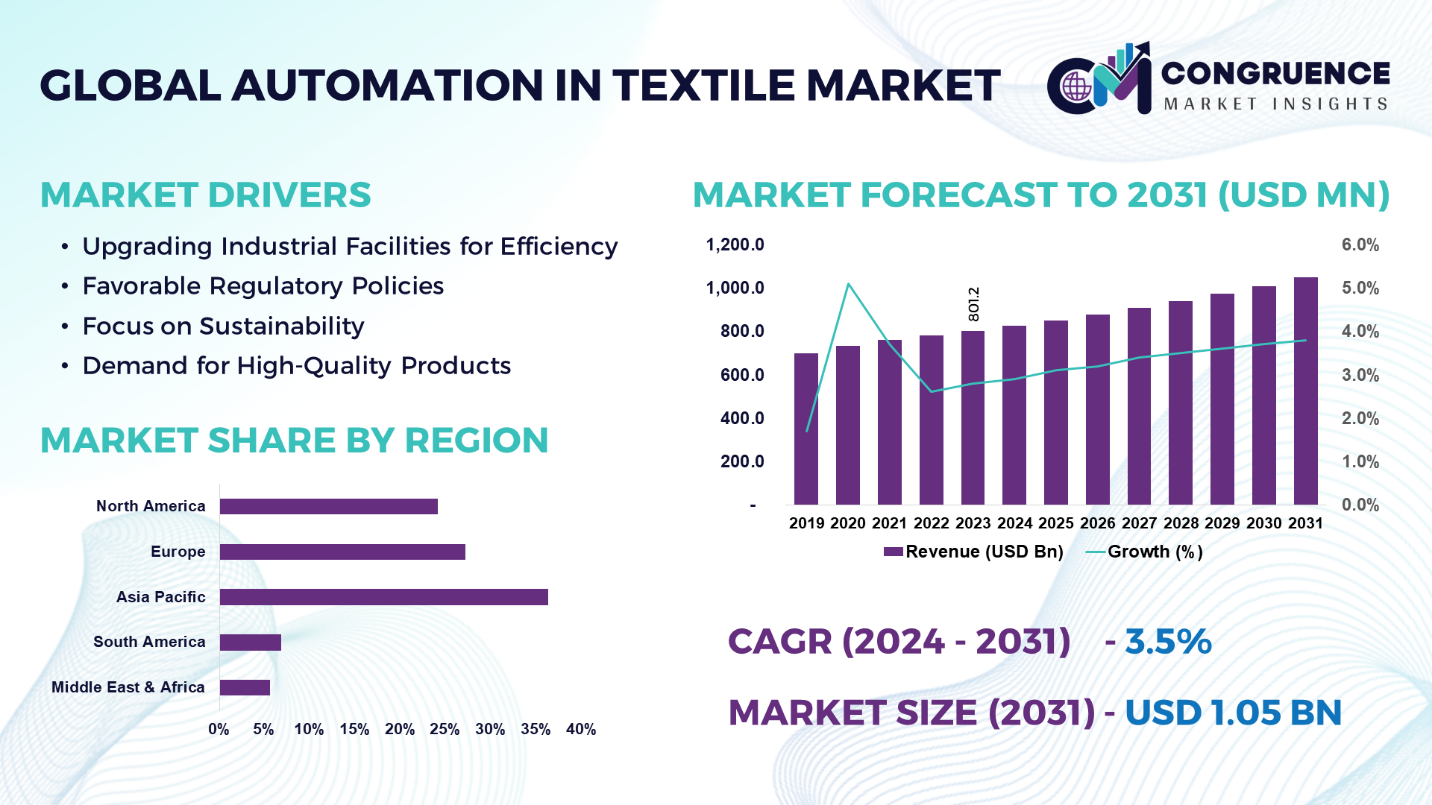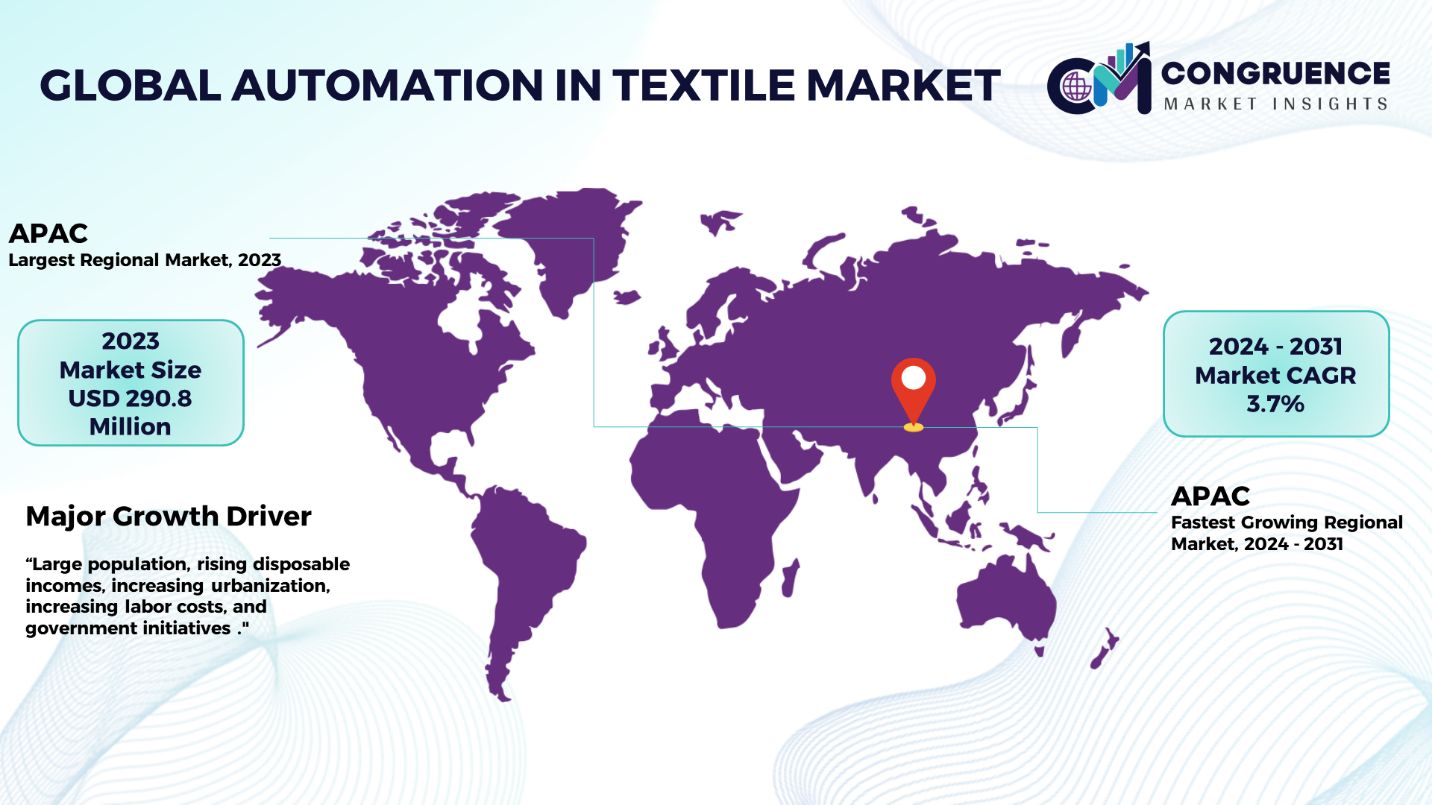Reports
The Global Automation in Textile Market was valued at USD 801.2 Billion in 2023 and is anticipated to reach a value of USD 1,046.9 Billion by 2031 expanding at a CAGR of 3.5% between 2024 and 2031.
Automation in textile is refers to the integration of advanced technologies, machine, and software to streamline and optimize various processes in the textile industry. Automation has transformed the textile manufacturing process, with increased efficiency, precision, and productivity. Automation systems replace manual labor with advanced technologies to help make production easier and more efficient. The main purpose of automation in textile is to increase efficiency, reduce labor costs, eliminates errors, and improve speed in production. Automation in textile industry makes repetitive tasks faster, increasing the productivity in industry. Automation used in textile industry for various stages of textile production, from spinning and weaving to dyeing and finishing. Automation offers numerous benefits to textile market, including increased productivity, reducing manual operations, reducing errors, enhanced operational efficiency, and ensure consistency in production. The market is influenced by factors such as upgrading industrial facilities for efficiency, favorable regulatory policies, focus on sustainability, and demand for high-quality products.

To learn more about this report, request a free sample copy
Automation in Textile Market Major Driving Forces
Upgrading Industrial Facilities for Efficiency: Many textile manufacturing facilities are investing in improving efficiency by implementing automation solutions. Many textile manufacturing facilities around the globe are upgrading to automated systems to improve operational efficiency, and to maintain the same quality of production.
Favorable Regulatory Policies: Governments around the world are recognizing the importance about the benefits of automation. Automation solutions help manufacturing facilities comply with stringent regulatory standards related to product quality, safety, and sustainability.
Focus on Sustainability: The growing emphasis on sustainability is also a significant factor fueling the demand for automation in textile industry. Automation solutions can contribute to sustainability by minimizing waste, optimizing resource utilization, and reducing environmental impact in textile production processes.
Demand for High-Quality Products: The increasing demand for high-quality and consistent textile products drives the growth of automation in textile industry. Consumers are increasingly seeking for high-quality and consistent products, drives adoption of automation for improved performance in manufacturing processes.
Automation in Textile Market Key Opportunities
Technological Advancements: Ongoing advancements in robotics, sensors, and control systems are expected to create opportunities for market growth. Furthermore, integration of emerging technologies, such as machine learning, computer vision, and IoT drives innovations in the textile industry.
Flexibility and Customization: Automation in the textile industry provide customization and flexibility in production, enabling manufacturers to quickly adapt to evolving consumer demands. Automation solutions enable efficient customization and flexibility in textile products to meet individual consumer preferences.
Expansion of Textile Industry: The rapidly growing global textile industry is anticipated to provide significant opportunities for market expansion. As the global textile industry continues to expand, there is a growing need for advanced automation technologies to meet the increasing demand. Automation enables textile manufacturers to significantly improve their productivity with greater precision and quality.
Automation in Textile Market Key Trends
· Integration of artificial intelligence, and machine learning for predictive maintenance and quality control in textile industry
· Ongoing advancements in technologies are driving product innovation and market expansion
· Integration of advanced robotics, IoT, digital twins, automated quality control, and big data analytics to enhance process optimization
· The growing use of ERP solutions in textile manufacturing plants that helps improve the process efficiency
· Many textile manufacturing facilities are investing in upgrading industrial facilities to improve energy efficiency
· Increasing demand for control devices and applications such as PLC, HMI, and MES is another significant trend in the textile industry
· The growing emphasis on sustainability in textile industry drives adoption of automation solutions that optimize resource usage, minimize waste, and reduce environmental impact
Region-wise Market Insights
Asia Pacific accounted for the largest market share at 36.3% in 2023 whereas, Asia Pacific is expected to register the fastest growth, expanding at a CAGR of 3.7% between 2024 and 2031.

To learn more about this report, request a free sample copy
Asia-Pacific is a rapidly growing region in the automation in textile industry and is predicted to be maintain its positon throughout forecast period. The market growth in this region is attributed to factors such as large population, rising disposable incomes, increasing urbanization, increasing labor costs, and government initiatives are driving the adoption of automation in textile industry. In North America, the demand is driven by a robust economy, technological advancements, Industry 4.0 initiatives, and a strong consumer base with high purchasing power. Europe is another significant market for automation in textile industry with major countries such as United Kingdom, Germany, and France. This region is characterized by a growing demand for high-quality textile products, and growing focus on sustainability. The Middle East and Africa has been witnessing a growing demand for automation in textiles with investment in modernizing textile industry whereas, in Latin America, the market is influenced by increasing labor costs, and government investments in textile manufacturing.
Market Competition Landscape
The global automation in textile market is highly consolidated with the presence of established and emerging vendors. Key players in the automation in textile market are adopting various growth strategies aimed at gaining a competitive edge. These strategies include product innovation, product launches, design differentiation, partnerships, collaborations, and the incorporation of emerging technologies to meet evolving consumer preferences. Established brands leverage their reputation for quality and reliability to maintain market share, while newer entrants focus on disruptive innovations and unique selling propositions.
Key players in the global automation in textile market implement various organic and inorganic strategies to strengthen and improve their market positioning. Prominent players in the market include:
· ABB Ltd
· Siemens AG
· Rockwell Automation Inc.
· Danfoss
· Festo Inc.
· Schneider Electric SE
· Rieter
· Fanuc Corporation
· Mitsubishi Electric Corporation
· Beckhoff Automation
· Honeywell International Inc.
· Bosch Rexroth AG
· Yokogawa Electric Corporation
· General Electric Company
|
Report Attribute/Metric |
Details |
|
Market Revenue in 2023 |
USD 801.2 Billion |
|
Market Revenue in 2031 |
USD 1,046.9 Billion |
|
CAGR (2024 – 2031) |
3.5% |
|
Base Year |
2023 |
|
Forecast Period |
2024 – 2031 |
|
Historical Data |
2019 to 2023 |
|
Forecast Unit |
Value (US$ Mn) |
|
Key Report Deliverable |
Revenue Forecast, Growth Trends, Market Dynamics, Segmental Overview, Regional and Country-wise Analysis, Competition Landscape |
|
Segments Covered |
· By Offering (Hardware, Software, and Services) · By Component (Field Devices, Control Devices, and Communication) · By Application (Spinning, Weaving, Dyeing & Finishing, Fabric Manufacturing, and Others) |
|
Geographies Covered |
North America: U.S., Canada and Mexico Europe: Germany, France, U.K., Italy, Spain, and Rest of Europe Asia Pacific: China, India, Japan, South Korea, Southeast Asia, and Rest of Asia Pacific South America: Brazil, Argentina, and Rest of Latin America Middle East & Africa: GCC Countries, South Africa, and Rest of Middle East & Africa |
|
Key Players Analyzed |
ABB Ltd, Siemens AG,Rockwell Automation Inc.,Danfoss,Festo Inc.,Schneider Electric SE,Rieter,Fanuc Corporation,Mitsubishi Electric Corporation,Beckhoff Automation,Honeywell International Inc.,Bosch Rexroth AG,Yokogawa Electric Corporation, and General Electric Company |
|
Customization & Pricing |
Available on Request (10% Customization is Free) |
